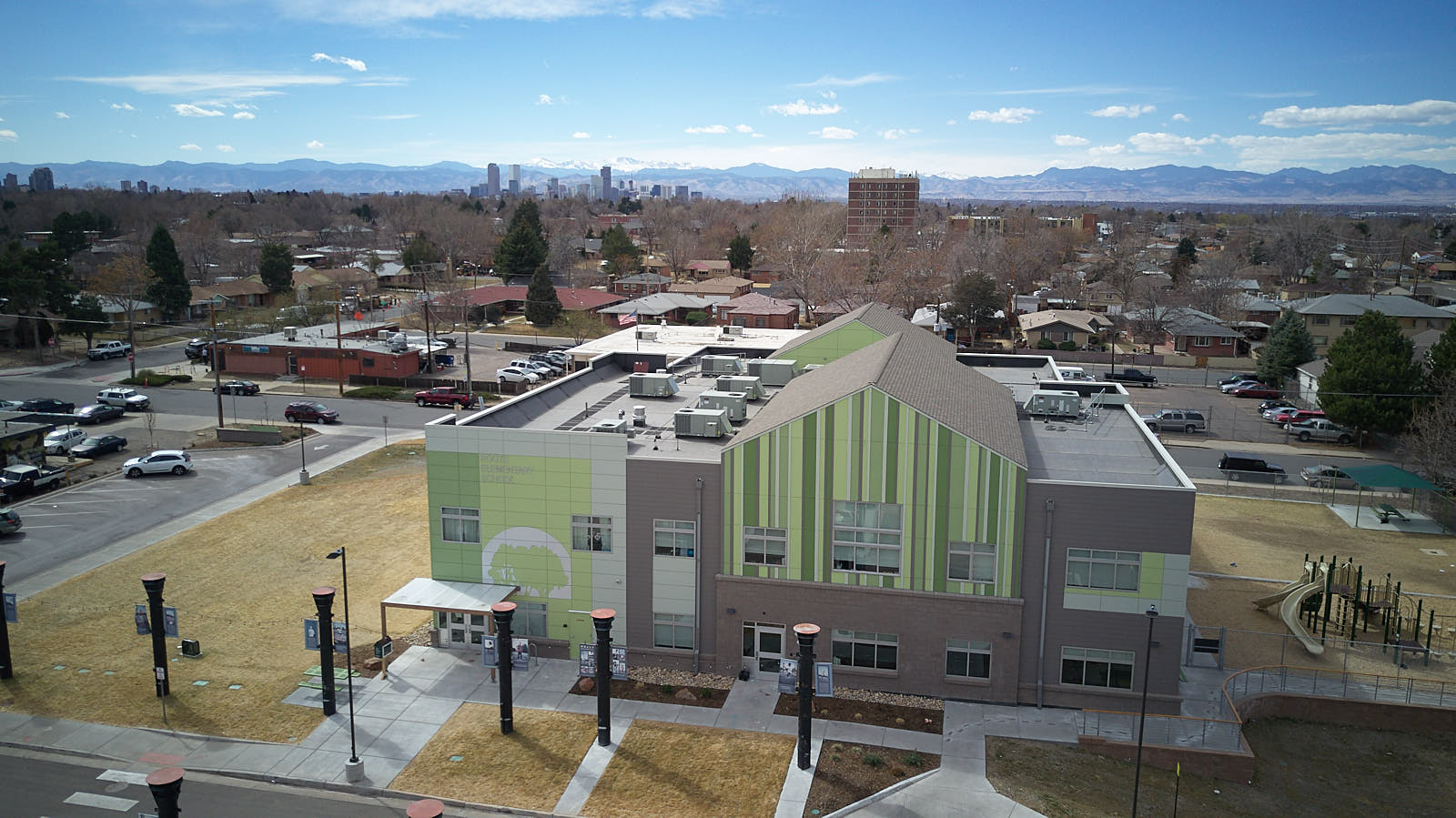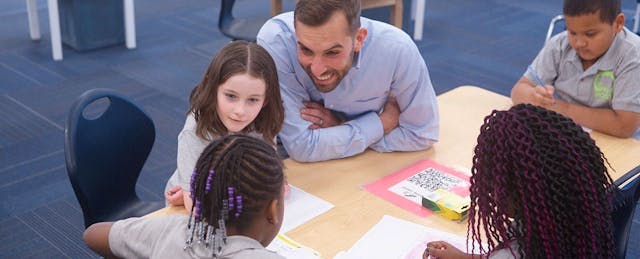In 2008, the Holly Square Shopping Center in northeast Denver was firebombed with molotov cocktails in gang-related arson. The next day, our neighborhood found an asbestos-ridden shell of a building where once stood the heart of the neighborhood. The community rallied to rebuild, and the community group in charge of redevelopment asked me to build a new school on the ashes of the former shopping center.
In 2015, we opened the doors of Roots Elementary to 100 kindergarteners and first graders in the neighborhood.

Two years later, I continue to be amazed and humbled everyday by the strength of our community—but the odds are stacked against our children. Most of them come from surrounding schools that consistently post some of the lowest reading and math scores in the state. About a quarter have witnessed a family member killed in gang violence, and nearly half have an immediate family member involved in the criminal justice system—and that’s before entering kindergarten.
From the start, we knew we needed an innovative approach to both academic instruction and social emotional development if we were to truly break the cycle of poverty and expand opportunity for all of our children.
Prior to founding Roots, I was a founding teacher at Rocky Mountain Prep. Before that I had worked at the Charter School Growth Fund with several of the early visionaries who supported the movement toward personalized learning. I was eager to move past the design features that have defined public school for the past century and re-imagine everything from the physical space to the human capital model to the use of technology.
When designing our school, we decided to literally knock down the walls between classrooms, specialize our staff into academic and non-academic teachers, and use technology to create personalized learning experiences for our students. Our goal was to provide every learner with the right content, at the right time, in the right way—regardless of grade level or arbitrary assignment to a classroom.
Some of our students thrived in this model. They loved having their own unique schedules and being in charge of moving themselves around the flexible space. But others struggled to find their way in the fluid learning environment and to build close relationships with their peers and teachers. Often, the students who struggled the most were those who had faced substantial trauma in their young lives—the students we’re most dedicated to serving at Roots.
During our second year, through a combination of reflection with our team and learning from experts in the field, we realized we had missed something—something big. There is a natural tension between personalized learning and community building. They are not completely at odds—there are even ways in which they are complementary—but we have learned that optimizing for one can come at the expense of the other.
In the personalized learning model we designed, classes were fluid and flexible so that learners could be grouped and regrouped throughout the day according to various needs. Students transitioned between different spaces, and worked with many peers and teachers throughout the day. While this allowed us to tailor academic instruction, it didn’t meet everyone’s social and emotional needs.
We had optimized too much for personalization and needed to renegotiate the balance. This was particularly urgent for us because a strong sense of community is critical for young children who have experienced trauma.
We needed to make a change.
Yes, our students were outperforming national averages in academic growth, and some were making remarkable gains, but we wanted our school to meet the needs of every learner—and that goes beyond academics. It's hard to catalyze change in a school that is experiencing success—but we knew we had to. So we started out on a path of exploration to identify what changes we could make that would help us reach the needs of all of our students.
The Redesign Process
To start we looked inward. Our leadership team spent months facilitating reflective processes with the broader school community. We asked students, parents and teachers what was working and what was not. It was clear there were many elements of our model that were working and should remain unchanged—specifically our core values of grit, relationships, ownership and wonder, and our belief that all kids are capable of extraordinary things. But soon the idea that we could do better gained momentum.
Then we turned outward to build our expertise in trauma-informed practice and get support to lead an effective transition. We turned to our partners at the Mental Health Center of Denver (MHCD). Not only does the staff have extensive expertise on child development, but MHCD recently opened a campus in our neighborhood which serves many of our students, so the staff understands their unique needs. Our entire staff participated in “Trauma 101” trainings led by MHCD and our leadership team spent hours brainstorming school structures that would support our kids who have experienced the most trauma.
We engaged a consultant, Lisa Stone, who has done similar work with the Achievement First Greenfield schools. Lisa helped us rethink our school-wide culture and consider what kind of teacher development would be necessary to implement change.
In addition, we participated in a professional learning group facilitated by Valor Collegiate Academies, a charter management organization in Nashville, Tennessee that has developed an highly effective approach to social and emotional learning. Valor only runs secondary schools so we worked with its leadership team to adopt their work for our younger students.
Five Most Critical Changes We Made
Teacher Roles
When we started Roots, we differentiated teacher roles to optimize for personalized learning. We divided the responsibilities of a traditional elementary school teacher into academic specialities and created a new position, which we called a “habits of success coach,” to focus on non-academic skills like social and emotional learning. This differentiation allowed teachers to become experts in their speciality and reach across grade levels to work with a greater number of students. Many students were thrilled to have six to eight teachers, but it came at the expense of forming smaller, tight-knit communities.
From our research we learned that young children who have experienced trauma need to go deeper rather than broader in their relationships to build healthy self-regulation. So we redesigned our staffing model to scaffold the number of relationships over time. Our kindergarteners now spend the bulk of their day with one lead teacher who is a generalist, and we gradually begin to specialize in first grade so students get the benefits that can come from a differentiated staffing model when they are ready for it.
Physical Space
We built our physical space to be as flexible as possible. This made it easier to group learners based on data because the space could be changed to fit the size and objective of the group. It also gave students more autonomy over the way they worked. However, we learned that for those children most impacted by trauma, the additional visual and auditory stimuli triggered unregulated responses, and were counterproductive to their learning. In response, we decided to install partial walls into the open spaces to give groups of students the ability to form a safe and secure sense of community, while simultaneously allowing them to move between spaces easily as they become ready for more personalized schedules.
Incorporating Circle
We adopted Circle, a structure developed by Valor Collegiate Academies, which is grounded in group therapy practices and is built to guide a journey of self-discovery while building a deep community of support. Teachers lead a 40-minute Circle each week with students, and the staff participates in Circle for an hour after school every Wednesday. This parallel between students and staff is based on research that suggests that being a caretaker for children who have experienced trauma is itself a traumatizing experience. Our staff also needs support to stay happy and healthy in their workspace.
Self-Regulation Routines
We introduced several systems aimed at helping our students strengthen their self-regulation muscles. Every teacher has built mindfulness and movement into the school day, and each classroom has a “regulation corner,” where students can go when they are having trouble self-regulating. In that space, students can choose a word or image that represents the emotion they are feeling and select an activity to calm down such as coloring, breathing, push-ups or reading a book.
Encouraging Results
We are two months into implementation and the changes are beginning to have an impact. Across the school, students are strengthening their relationships with both peers and teachers, and we are still able to personalize learning in the ways that hold true to our vision.
Roots Elementary parent Elyssa DiMinno says, “Last year, kids moved from place to place a lot, and I know there were good intentions with it, but it took a lot of self-regulation. For my son the extra stimulation was hard because of all that was going on in his life at home. I love how everything was simplified this year. It's more cohesive and has helped my son stay focused."
We’ve still got a long road ahead, but the results are encouraging, and I hope that by sharing what we’ve learned, we can help others who are building the next generation of schools.
Jon Hanover is the founder and executive director of Roots Elementary School.


